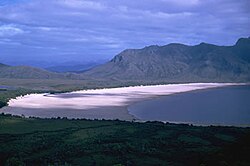Biology:Lake Pedder planarian
From HandWiki
Short description: Species of flatworm
| Lake Pedder planarian | |
|---|---|
| Scientific classification | |
| Domain: | Eukaryota |
| Kingdom: | Animalia |
| Phylum: | Platyhelminthes |
| Order: | Tricladida |
| Family: | Dugesiidae |
| Genus: | Romankenkius |
| Species: | †R. pedderensis
|
| Binomial name | |
| †Romankenkius pedderensis Ball, 1974
| |
The Lake Pedder planarian (Romankenkius pedderensis) is a species of invertebrate in the family Dugesiidae.[3]
Distribution and conservation status
The species is endemic to the Lake Pedder area in Tasmania, Australia. This species has been listed as extinct by the IUCN Red List of Threatened Species since 1986, although their last conservation assessment was dated 1996.[2] Live specimens of this species were collected in 2006[4][failed verification] and the ongoing existence of the species was again confirmed in 2012.[1]
See also
References
- ↑ 1.0 1.1 Forteath, GNR; Osborn, AW (2012). "Survival of endemic invertebrates of Lake Pedder and Lake Edgar subsequent to inundation". Records of the Queen Victoria Museum 116. https://www.biodiversitylibrary.org/page/57547527.
- ↑ 2.0 2.1 World Conservation Monitoring Centre (1996). "Romankenkius pedderensis". IUCN Red List of Threatened Species 1996: e.T19741A9008480. doi:10.2305/IUCN.UK.1996.RLTS.T19741A9008480.en. https://www.iucnredlist.org/species/19741/9008480.
- ↑ Sluys, Ronald; Kawakatsu, Masaharu; Riutort, Marta; Baguñà, Jaume (2009). "A new higher classification of planarian flatworms (Platyhelminthes, Tricladida)". Journal of Natural History 43 (29–30): 1763–1777. doi:10.1080/00222930902741669.
- ↑ Grant, Lauryne J.; Sluys, Ronald; Blair, David (2006). "Biodiversity of Australian freshwater planarians (Platyhelminthes: Tricladida: Paludicola): New species and localities, and a review of paludicolan distribution in Australia". Systematics and Biodiversity 4 (4): 435–471. doi:10.1017/S1477200006002064.
Wikidata ☰ Q2006135 entry
 |



